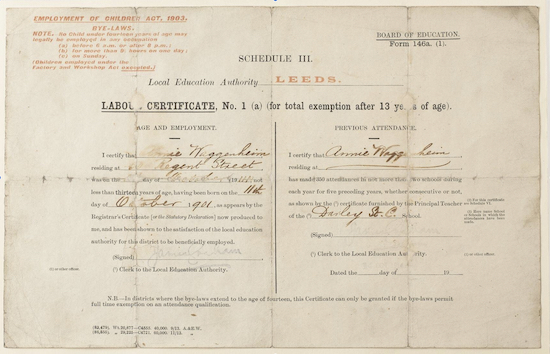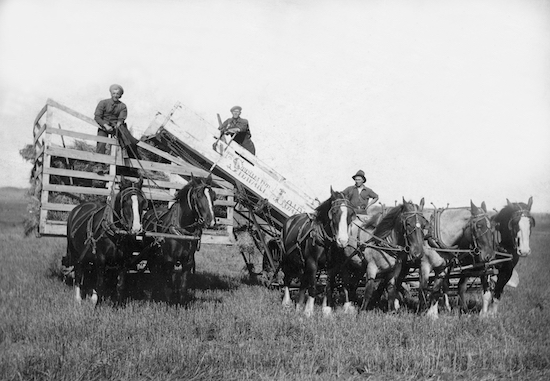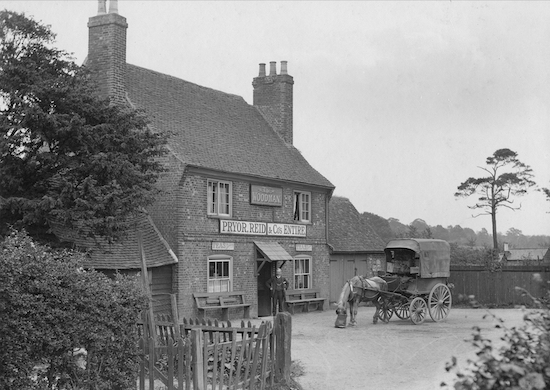 |
| Water End School c 1903. Headmistress Mrs Cooke on the left Image part of the Images of North Mymms Collection |
This collection of memories of life in North Mymms at the turn of the 20th century and up to and including WWII is just one of several collected over the years by the former North Mymms Local History Society (NMLHS). Many are published on this site.
The original written memories have been shortened and comments have been added by the North Mymms History Project (NMHP). Those comments appear in italics and enclosed in parentheses. These addition are in order to add information. Throughout the piece we have added relevant maps, images, and links where we felt appropriate.
Early memories of Welham Green
by Eleanor Vyse 1887-1976
 |
| Queen Victoria's carriage outside St Paul's Cathedral, 22 June 1897 Photograph: London Stereoscopic and Photographic Company - Wikimedia Click on image for a larger version |
 |
| The location of the cricket field, where Welham Close now is, marked in red Click on the map for a larger version without the marking OS 25 inch 1898 map courtesy of the National Library of Scotland |
School years
I went to Water End School. At school I did NOT like the schoolmistress. She was stern and wore a lace cap and controlled most of the 60 or so children by just looking at us, or so it appeared. Her hands were smooth and glossy. She always wore black dresses with many buttons down the bodice and full skirts to the ground.
(The schoolmistress Eleanor did not like would have been Mrs Letitia Haines, not Mrs Cooke who appears in the first photo and who was well liked.)
 |
| Water End School c. 1900s Image G Knott, from the Peter Miller Collection |
(You can read more about Water End School in the Schools chapter of Dorothy Colville's book, 'North Mymms - Parish and People', and in Peter Kingsford's book, 'North Mymms Schools and their Children 1700-1964', which are both published on this site.)The South African War was in progress about that time and I remember we were told in school when Mafeking was relieved. The rest of the day was a holiday.
 |
| St Mary's Church and vicarage c. 1900 Photograph G Knott, part of the Images of North Mymms Collection |
 |
| The vicarage and gardens seen from St Mary's tower - 1993 Photograph by Ron Kingdon, part of the Images of North Mymms Collection |
Leaving school early
I left school at 12½ having passed the Labour Examination. For the next year I stayed at home to help my mother as there was a lot to do with five of us at home - children I mean.
(Eleanor Vyse probably meant 'labour certificate' rather than 'labour examination'. Labour certificate were granted to children by local education authorities allowing them to leave school early in order to take up work, in Eleanor's case as a ‘mother's help’. See an example of a labour certificate of 1901 below.)
 |
| A 'labour certificate' allowed the holder to leave school in order to work Image © Victoria and Albert Museum, London, used with permission |
 |
| Haymaking c.1910 Photograph gifted by B Hickson, part of the Images of North Mymms Collection |
(A bushel is a measure of capacity used for corn, fruit, liquids, etc. The pre-decimal currency system consisted of a pound of 20 shillings or 240 pence. A shilling was shorted to 's' and a penny was shortened to 'd'.)
 |
| Pony and cart was a common form of transport in North Mymms This one carrying members of the Shadbolt and Nash families - 1912 Image from the NMLHS part of the Images of North Mymms Collection |
(Ludwick Farm no longer exists, but it would have been in an area called Hatfield Hyde, situated approximately where Hall Grove and Archers Ride is today, location - https://w3w.co/pace.shapes.risen. The journey, described by Eleanor Vyse, from Ludwick Farm to her home in Welham Green would have probably followed the route on the map below. She recalled that the round trip was 10 miles. The route on the map below is five miles each way. The green line is the probable route taken, the blue icon is where Ludwick Farm would have been, and the red icon would have been Eleanor's home.)
 |
| Eleanor's possible route from Ludwick Farm to Welham Green Map created on MapHub by the NMHP - click on map for a larger version Elements © Thunderforest © OpenStreetMap contributors |
From home help to post office assistant
I had been in this place a year, receiving 1s. 6d, a week all found of course (all found means with everything provided, such as food, electricity, heating and laundry, at no additional cost. The job is live-in and all found.), but I left soon afterwards and again had a short time at home helping my mother when the post-mistress came and asked my mother if I could go to be post office assistant. I was 14 and a half when I took up the post, or it took me up. The hours were 8 a.m. to 8 p.m. with an hour off for dinner at midday. For this I received four shillings per week. The work was interesting and not hard except that I was expected to do a good many chores for the post-mistress, a Frenchwoman who, years before, had been lady's maid to the vicar's wife, Mrs Latter.
I remember having to go to a magistrate to take the oath not to divulge anything which came to my knowledge by being in the post office. This meant another ride in a pony-cart - a treat in those days - to a gentleman who lived four miles away at Mimwood. He was Mr Archibald Thompson, Chairman of the Parish Council, in fact the first chairman of the North Mymms Parish Council. When he died in 1916 a memorial to him was placed in church. It is in the stall where the vicar sits during the services.
 |
| Mimwood House, Shepherds Way - 1982 Image from the former NMLHS, part of the Images of North Mymms Collection |
I didn't do any divulging except when the news came through that King Edward's coronation was to be postponed. I knew that was expected and would soon be known by all anyway, but I got a stern reprimand — but the postman DID ask me. (not my postman).
I stayed with that and my four shillings a week for two years. The post mistress was not an easy woman to be with, and my brothers used to tell me that if I stayed much longer with that old woman I'd grow like her that is bad-tempered. The prospects were NIL for getting a better position and pay in the post office so I went to service again.
The two world wars
Towards the end of the war with Germany, 1914—1918, I joined the Army Pay Corps at Hounslow. I don't know how I had the nerve and don't ask me how I got to Hounslow from North Mymms. However I had heard of it and I itched to do war work of some kind.
(Eleanor's memories continued with several paragraphs about working for the Royal Army Pay Corps in Hounslow, but we have not included these in this edited account because of their lack of direct relevance to the history of North Mymms.)The war came to an end whilst I was at Hounslow and no work was done on that November day. Two of my fellow-lodgers and I went up to London that evening and got as near to Buckingham Palace as we could. The crowd there was enormous; one could not move but had to go as the crowd took us, cheering, until we were nearly hoarse, the royalty when they came out on to a balcony. However, we got back to Hounslow at last and went to the office next morning. There was still plenty to do before things were finally cleared up. I would have liked to stay to the end, though the sitting down work did not agree with me after the activity of working as a house maid, but tragedy happened at my own home and was allowed to leave at once.
After America entered the Second World War the 'American Army Hospital sprang up in North Mymms Park almost overnight. After a time a local lady organised a party of village women as volunteer needle-women to do some necessary sewing for the men. There were four of us. Most of the work was sewing braid on their forage caps, sewing stripes of rank on their sleeves - upside-down - shortening trousers or putting new collars and cuffs on their shirts. Sometimes one of the women staff got us to mend something for her.
It was a long walk from Welham Green to the hospital and once I got through the wire railings to take a short cut. A sentry was there with a gun and told me off. I told him why and what I was going for and he let me go past.
"There ain't no beer"
 |
| The Woodman Inn c 1900 Photograph by G. Knott, gifted by R. Papworth Part of the Images of North Mymms Collection |
 |
| The Old Maypole in the 1940s Photograph from the former NMLHS Part of the Images of North Mymms Collection |
(The two nearest pubs to the American Hospital were The Woodman Inn and The Old Maypole. Click here for a slideshow of North Mymms pubs over the years.)At the end of things we, with lots of others who had helped in some way, were given a party and we needle workers were given a certificate by the American Red Cross. It is dated 29th June 1945. I am the only one left of the four.
(Eleanor Vyse died on 23 July 1976.)
 |
| Eleanor Vyse (left), with Lorna Jarman and Daphne Jarman Photographed by R Kingdon in the 1950s - Images of North Mymms Collection |
The following tribute was paid to Eleanor Vyse by local author and historian, the late Dorothy Colville.
Born more than 88 years ago her early childhood was spent in the Water Splash area of the parish. She attended the Girls' School at Water End where the principal subjects on the curriculum were the 3 R's, the Church Catechism and Needlework — subjects which had a great influence on her life.
Quiet and reserved she had a dry sense of humour and was a keen judge of character. She did not suffer fools gladly.
During the early days of the School Meals Service, she served in one of the then newly built shops in Dellsome Parade, she was one of a small group of volunteers who served the meals and supervised the children during their midday 'break'.
An even smaller group did a weekly 'mend and button replacement' for the men at the American Hospital at North Mymms Park. For this the American Red Cross bestowed a Certificate of Loyal Service to each.
A staunch member of the W.I. her needlework was shown in London at one of the exhibitions organised by the Federation. During the 1939-45 War the W.I., by the collection of waste paper, was able to give a small money gift at Christmas to every serving man and woman in the parish. Miss Vyse walked miles delivering the gifts and making sure no one was forgotten.
Apart from these activities her life was devoted to the service of her family and the friends she gathered around her.
May she rest in peace.
D. Colville
Comments and information welcome

If you have anything to add to this feature, or just want to add your comments, please use the comment box below.
No comments:
Post a Comment
Comments on this piece
If you have any information to add to this item, please use the comment box below. We welcome input and are keen to update any piece with new research or information. Comments are pre-moderated, so there will be a delay before they go live. Thanks
Further information
If you require any further information relating to this, or any other item, please use the contact form, because we are unable to reply directly to you via this comment box. You can access it from the 'contact us' link at the top of any page on the website, at the bottom of the right hand side of the website, or at the bottom of any page.